You know that moment when you first learn to cook something that's not just your typical pritong liempo or adobo? For me, these Chinese-style Salt and Pepper Pork Chops were my first "pwede na sa restaurant" moment.
I still remember how proud I felt serving this to my family, watching their eyes light up as that signature pepper-garlic aroma filled our tiny house. Napahiya yung usual takeout namin from the Chinese restaurant sa kanto!
This recipe holds a special place in my heart because it taught me that sometimes the simplest ingredients – just good pork, salt, pepper, and garlic – can create the most impressive results. Every time my siblings come over, they always request "yung super lutong na pork chop mo.
Once you master this recipe (and it's really not as hard as it looks), you'll never look at ordinary pritong pork chop the same way again. Plus, you'll save so much money vs. eating out. Tipid tips na, masarap pa!
Jump to:
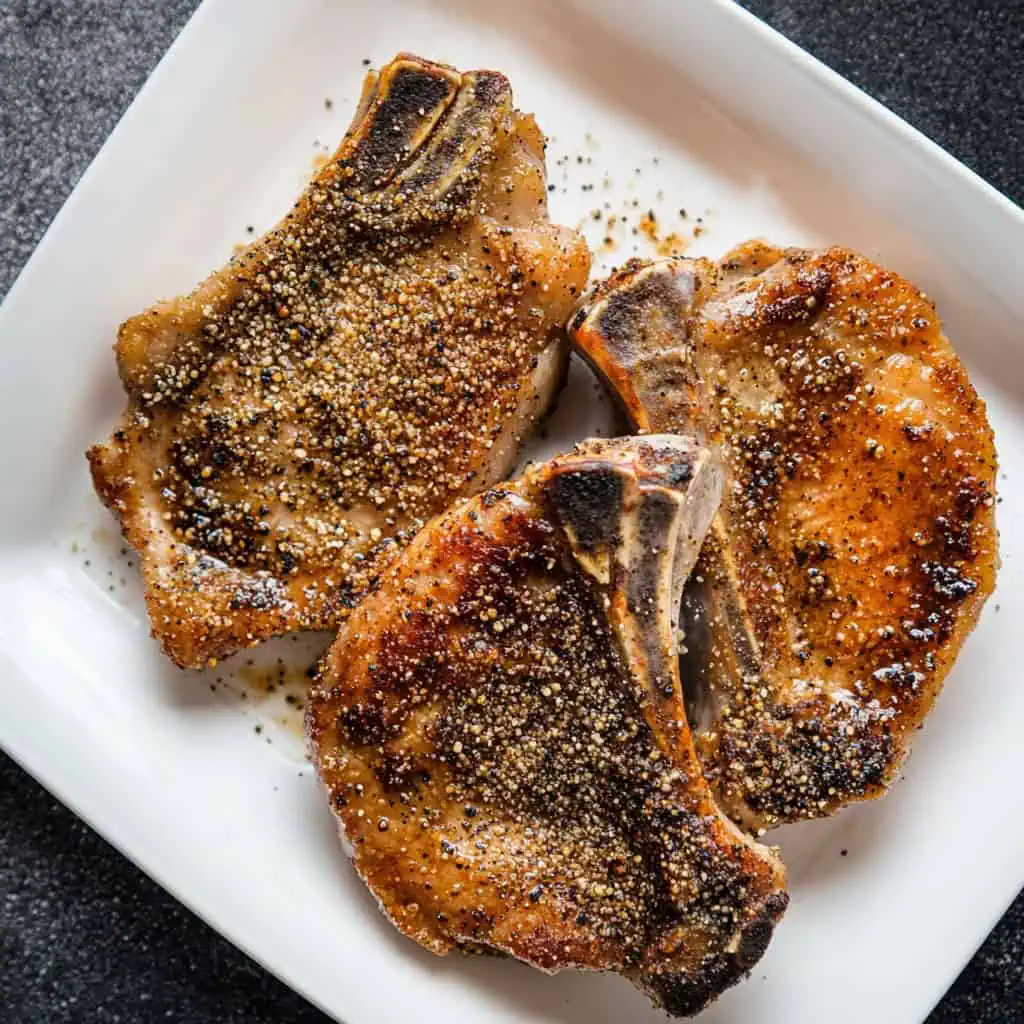
Why You'll Love This Recipe
- Restaurant-Quality Results: Achieve that perfect combination of crispy exterior and juicy interior that rivals your favorite Chinese restaurant
- Budget-Friendly: Create a premium dish at a fraction of restaurant prices
- Foolproof Technique: Master the Chinese velveting method that guarantees tender meat every time
- Versatile: Easy to customize the spice level and seasonings to your taste
- Family-Friendly: A guaranteed crowd-pleaser that even picky eaters will love
Ingredients
These ingredients create the perfect balance of flavors and textures that make Salt and Pepper Pork Chops special. Bone-in pork chops provide more flavor and stay juicier during cooking than boneless cuts. The egg white tenderizes the meat through a Chinese technique called velveting, while cornstarch creates that signature crispy coating.
Canola oil works wonderfully for deep-frying due to its high smoke point and neutral taste. The aromatic combination of garlic, jalapeños, and green onions creates a savory-spicy flavor profile that enhances the simplicity of salt and pepper seasoning.
Together, these ingredients transform an everyday cut of meat into a restaurant-quality dish that's both impressive and approachable for home cooks.
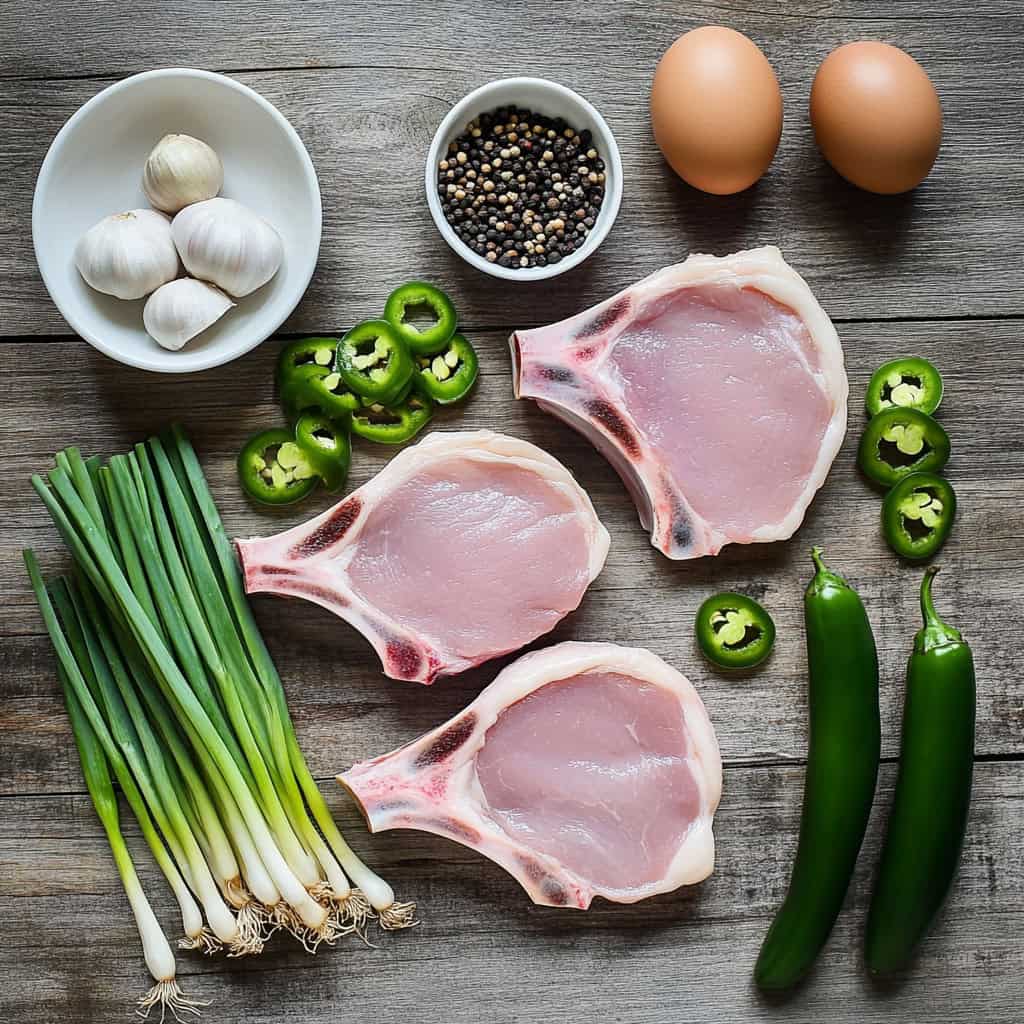
- 4 bone-in pork chops, ½-inch thick
- 1 egg white
- 1½ teaspoons salt, divided
- ¾ cup cornstarch
- Canola oil for deep-frying
- ¼ teaspoon ground black pepper
- 1 head garlic, peeled and minced
- 2 jalapeños, thinly sliced
- 2 green onions, chopped
Equipment
- Deep frying pan or wok: Essential for achieving the proper frying depth and even cooking of the pork chops
- Wire rack: Allows excess oil to drain from the fried pork chops while maintaining crispiness
- Meat thermometer: Ensures pork is cooked to the perfect internal temperature (145°F/63°C) for food safety and optimal texture
- Paper towels: For patting the meat dry before marinating and coating
- Heavy-bottomed pan: For the final sautéing of aromatics and tossing with the fried pork chops
- Sharp knife: For scoring the fatty edges to prevent curling during cooking
- Large mixing bowl: For marinating the pork chops in the egg white mixture
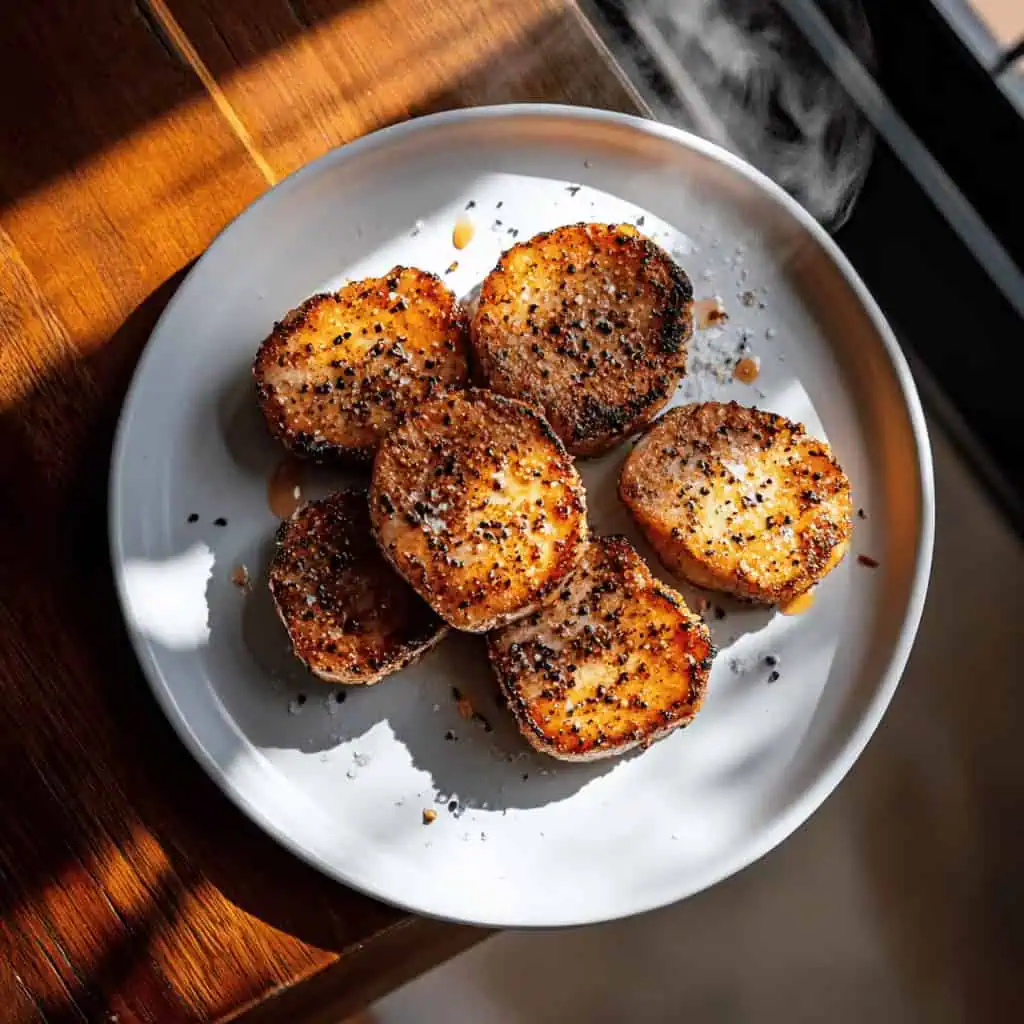
How To Make
- Take the pork chops out of the refrigerator 30 minutes before cooking to reach room temperature. While waiting, mince one whole head of garlic, thinly slice two jalapeños, and chop two stalks of green onions.
- Clean your pork chops thoroughly and pat them completely dry with paper towels. Using a sharp knife, score the fatty edges of each pork chop in several places to prevent curling during cooking.
- In a large bowl, whisk one egg white with half a teaspoon of salt until it becomes frothy. Place your pork chops in this mixture and coat them evenly. Cover the bowl with plastic wrap and refrigerate for exactly 30 minutes.
- Pour enough cooking oil into a deep, heavy-bottomed pan or wok to reach a depth of about 3 inches. Heat the oil to exactly 350°F/175°C. If you don't have a thermometer, test the oil by dropping a small piece of coating - it should sizzle immediately and rise to the surface.
- Remove the pork chops from the refrigerator. Place ¾ cup of cornstarch on a plate. Take each pork chop and dredge it thoroughly in the cornstarch, shaking off any excess. Place the coated pork chops on a clean plate.
- Carefully lower each pork chop into the hot oil. Cook for 5-7 minutes, turning once halfway through, until golden brown and crispy. The internal temperature should reach 145°F/63°C. Don't overcrowd the pan - cook in batches if necessary.
- Transfer the fried pork chops to a wire rack to drain excess oil. Keep them warm while you prepare the aromatics.
- Heat 2 tablespoons of oil in a clean wok or large pan over medium-high heat. Add the minced garlic and stir-fry until fragrant but not brown, about 30 seconds. Add the sliced jalapeños and continue stirring for another 30 seconds.
- Return all the fried pork chops to the pan and add the chopped green onions. Sprinkle with the remaining teaspoon of salt and ¼ teaspoon of ground black pepper. Toss everything together quickly just until the pork chops are evenly coated with the aromatics.
- Transfer immediately to a serving plate. Serve hot with steamed rice. Garnish with additional chopped green onions if desired.

Tips from Lola's Kitchen
- Quality matters: Choose pork chops with a pinkish-red color and good marbling for the juiciest results
- The secret is in the drying: Pat meat thoroughly dry before marinating – this is crucial for a crispy coating
- Patience pays off: Don't rush the 30-minute marinating time – this is what creates that tender texture
- Temperature control: Maintain oil at 350°F throughout cooking – too hot will burn the outside before the inside cooks, too cool will make the chops soggy
- The sound test: Listen for the sizzle when you add the pork to the oil – a strong, steady sound means your temperature is right
- Batch cooking: Never overcrowd your pan – leave at least an inch between pieces when frying
- Timing is everything: Have all your aromatics prepared before frying the pork so you can work quickly in the final step
Substitutions
- Meat choice: Boneless pork chops work well but reduce cooking time by 1-2 minutes
- Starch options: Potato starch can replace cornstarch for an even crispier exterior
- Heat level: Bird's eye chilies (siling labuyo) can replace jalapeños for more heat
- Aromatics: Shallots make a nice substitute for green onions for a deeper flavor
- Cooking oil: Any neutral high-heat oil works – vegetable, peanut, or rice bran oil are good alternatives to canola
- Egg white alternative: If you have an egg allergy, 2 tablespoons of buttermilk can work as a substitute in the marinade
Troubleshooting
- Problem: Soggy coating
- Solution: Ensure oil is hot enough (350°F) and don't overcrowd the pan. Make sure pork is very dry before coating.
- Problem: Dry, tough meat
- Solution: Don't skip the velveting process with egg white, and avoid overcooking. Use a meat thermometer to ensure you reach 145°F but don't exceed it.
- Problem: Burnt coating but undercooked interior
- Solution: Your oil is too hot or pork chops are too thick. Maintain proper temperature and consider butterflying very thick chops.
- Problem: Curled pork chops
- Solution: Score the fatty edges in several places before cooking to prevent curling.
- Problem: Bland flavor
- Solution: Season in layers – salt in the marinade, then again with the aromatics. Don't skimp on the garlic and make sure to toss thoroughly.
Storage & Reheating
- Allow pork chops to cool completely before storing
- Place in an airtight container with layers separated by parchment paper
- Store in refrigerator for up to 3 days at 40°F (4°C) or below
- For freezing: Wrap individual chops in plastic wrap then foil and freeze for up to 1 month
- To reheat: Place in a 350°F oven on a wire rack with a small splash of water underneath for 10-15 minutes until hot and crispy
- Avoid microwave reheating as this will make the coating soggy and ruin the texture
- Add a fresh garnish of chopped green onions after reheating to brighten the flavor
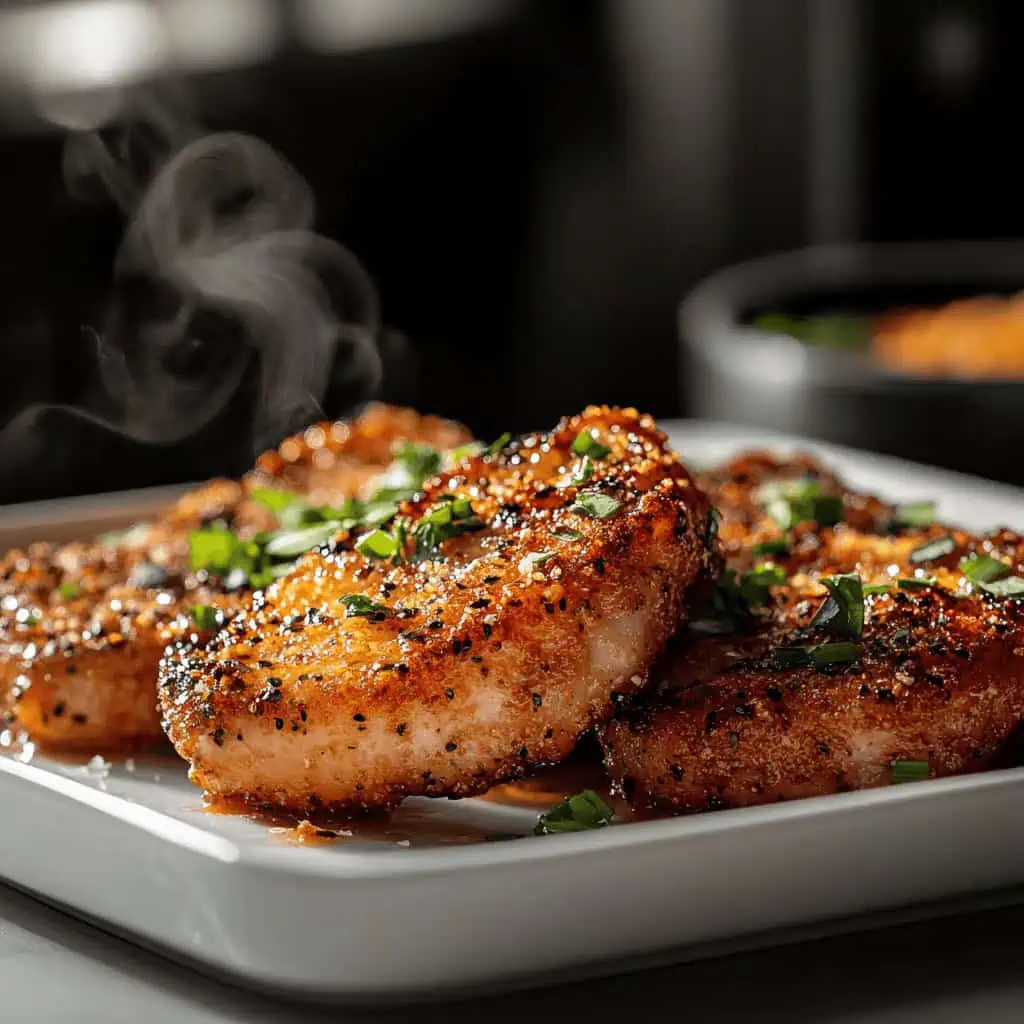
FAQ
Can I use an air fryer for this recipe?
Yes! Spray the coated pork chops with oil and cook at 400°F for 12-15 minutes, flipping halfway. The texture won't be identical to deep-frying but still delicious.
Why is the velveting step with egg white so important?
Velveting creates a moisture barrier that protects the meat during high-heat cooking, ensuring juicy meat inside while allowing a crispy exterior to form.
Can I prepare this dish in advance for a party?
You can complete the velveting process up to 8 hours ahead and keep refrigerated, but for best results, do the frying and final aromatic toss just before serving.
How do I know when the pork is done without a thermometer?
Cook until golden brown and the juices run clear when pierced with a knife. For a ½-inch thick chop, this should take about 5-7 minutes total.
Can I make this dish less spicy for kids?
Absolutely! You can omit the jalapeños entirely or replace them with mild bell peppers for color without heat.
What's the best cut of pork to use?
Center-cut rib or loin chops work best. Look for chops about ½-inch thick with some fat marbling for the juiciest results.
Can I use the same technique with chicken?
Yes! Boneless chicken thighs work wonderfully with this method. Adjust cooking time to ensure chicken reaches 165°F internal temperature.
Is there a way to make this dish healthier?
While deep-frying gives the best results, you can pan-fry in less oil or use an air fryer as mentioned above. The velveting process still helps maintain moisture.
Related
Looking for other recipes like this? Try these:

Salt and Pepper Pork Chops (Pritong Porkchop na may Asin at Paminta)
Equipment
- Deep frying pan or wok (Kawaling malalim o wok)
- Wire rack (Parilya)
- Meat thermometer (optional) (Termometro para sa karne)
- Kitchen paper towels (Papel na pampunas)
Ingredients
- 4 bone-in pork chops ½-inch thick (4 pirasong pork chop na may buto, ½ pulgadang kapal)
- 1 egg white 1 puting ng itlog
- 1½ teaspoons salt 1½ kutsaritang asin
- ¾ cup cornstarch ¾ tasang cornstarch
- Canola oil for deep-frying Canola oil para sa pagpiprito
- ¼ teaspoon ground black pepper ¼ kutsaritang dinurog na paminta
- 1 head garlic peeled and minced (1 buong bawang, tinadtad)
- 2 jalapeños thinly sliced (2 jalapeño, pinahiwa ng manipis)
- 2 green onions chopped (2 sibuyas na mura, trinopo)
Instructions
- Take the pork chops out of the refrigerator 30 minutes before cooking to reach room temperature (Ilabas ang pork chop 30 minuto bago lutuin). While waiting, mince one whole head of garlic (tadtarin ang isang buong bawang), thinly slice two jalapeños or siling haba (pahiwaing manipis ang siling haba), and chop two stalks of green onions.
- Clean your pork chops thoroughly and pat them completely dry with paper towels (Linisin at patuyuing mabuti ang pork chop gamit ang paper towel). Using a sharp knife, score the fatty edges of each pork chop in several places to prevent curling during cooking.
- In a large bowl, whisk one egg white with half a teaspoon of salt until it becomes frothy (Batihin ang isang puting ng itlog at kalahating kutsaritang asin hanggang bumula). Place your pork chops in this mixture and coat them evenly (Ilagay at ibalot ng mabuti ang pork chop sa pinaghalong puting ng itlog). Cover the bowl with plastic wrap and refrigerate for exactly 30 minutes (Takpan ng plastic wrap at ilagay sa ref ng eksaktong 30 minuto).
- Pour enough cooking oil into a deep, heavy-bottomed pan or wok to reach a depth of about 3 inches (Maglagay ng sapat na mantika sa kawali, mga 3 pulgada ang lalim). Heat the oil to exactly 350°F/175°C (Initin ang mantika hanggang umabot sa 350°F/175°C). If you don't have a thermometer, test the oil by dropping a small piece of coating - it should sizzle immediately and rise to the surface (Kung walang termometro, subukan ang init sa pamamagitan ng paghulog ng kaunting coating - dapat mag-sizzle agad at lumutang).
- Remove the pork chops from the refrigerator. Place ¾ cup of cornstarch on a plate (Maglagay ng ¾ tasang cornstarch sa pinggan). Take each pork chop and dredge it thoroughly in the cornstarch, shaking off any excess (Ibalot ang bawat pork chop sa cornstarch at tanggalin ang sobra). Place the coated pork chops on a clean plate.
- Carefully lower each pork chop into the hot oil. Cook for 5-7 minutes, turning once halfway through, until golden brown and crispy (Iprito ng 5-7 minuto, baliktarin isang beses, hanggang maging gintong-brown at malutong). The internal temperature should reach 145°F/63°C (Ang loob ng karne ay dapat umabot sa 145°F/63°C). Don't overcrowd the pan - cook in batches if necessary (Kung kailangan ay magluto ng paisa-isa).
- Transfer the fried pork chops to a wire rack to drain excess oil (Ilipat sa parilya para tumulo ang sobrang mantika). Keep them warm while you prepare the aromatics (Panatilihing mainit habang inihahanda ang mga pampalasa).
- Heat 2 tablespoons of oil in a clean wok or large pan over medium-high heat (Mag-init ng 2 kutsarang mantika sa malinis na kawali). Add the minced garlic and stir-fry until fragrant but not brown (Igisa ang tinadtad na bawang hanggang mabango ngunit hindi kulay brown), about 30 seconds. Add the sliced jalapeños and continue stirring for another 30 seconds (Idagdag ang siling haba at igisa ng 30 segundo).
- Return all the fried pork chops to the pan and add the chopped green onions (Ibalik ang mga pritong pork chop sa kawali at idagdag ang sibuyas mura). Sprinkle with the remaining teaspoon of salt and ¼ teaspoon of ground black pepper (Budburan ng natitirang asin at paminta). Toss everything together quickly just until the pork chops are evenly coated with the aromatics (Haluin ng mabilis hanggang mabalutan ng pampalasa ang pork chop).
- Transfer immediately to a serving plate (Ilipat agad sa serving plate). Serve hot with steamed rice (Ihain ng mainit kasama ang kanin). Garnish with additional chopped green onions if desired (Maaaring lagyan ng karagdagang sibuyas mura sa ibabaw).
- For best results when storing, let the pork chops cool completely (Palamigin mabuti), then place in an airtight container. They will keep in the refrigerator for up to 3 days (Tatagal ng hanggang 3 araw sa ref). To reheat, place in a 350°F/175°C oven with a small splash of water until hot and crispy (Initin sa 350°F/175°C na oven na may kaunting tubig hanggang uminit at maging malutong muli). Avoid using the microwave as this will make the coating soggy (Iwasang gamitin ang microwave dahil magiging malata ang balat).
Tips from Lola's Kitchen
- Choose pork chops with a pinkish-red color and marbling
- Pat meat dry thoroughly before marinating
- Don't skip the resting time after coating with cornstarch
- Use a thermometer to ensure oil temperature
- Let meat rest at room temperature 15 minutes before cooking
Nutrition
The Story Behind Salt and Pepper Pork Chops
Growing up in bustling Chinatown neighborhoods, Salt and Pepper Pork Chops (椒盐排骨) emerged as a shining example of Cantonese culinary mastery in the 1950s. Originally served in Hong Kong's dai pai dong (open-air food stalls), this deceivingly simple dish captured the essence of Cantonese cooking's "wok hei"—the elusive breath of the wok that transforms humble ingredients into extraordinary flavors.
While the Western world was familiar with breaded pork chops, Chinese chefs revolutionized the preparation by introducing the velveting technique. This method, dating back to the Tang Dynasty (618-907 AD), was originally reserved for imperial kitchens where chefs would use egg whites to ensure the emperor's meat remained tender. The technique gradually made its way into everyday cooking, becoming the secret behind many beloved Chinese restaurant dishes.
The genius of Salt and Pepper Pork Chops lies in its balance of textures and flavors. The dish exemplifies the Chinese cooking philosophy of "fan-qie"—the contrast between plain and seasoned elements. Each bite delivers a symphony of sensations: the crackle of the golden crust gives way to juicy meat, while the aromatic mix of garlic, jalapeños, and green onions provides a perfect counterpoint to the simple salt and pepper seasoning.
Today, this dish has transcended its humble street food origins to become a staple in Chinese restaurants worldwide. Its popularity has spawned countless variations, from the night markets of Taiwan to the Asian fusion restaurants of San Francisco. Yet the core appeal remains unchanged—it's a masterclass in how proper technique and simple seasonings can elevate an everyday cut of meat into something extraordinary.
What makes this recipe particularly special for home cooks is that it demystifies restaurant-quality Chinese cooking. By mastering the velveting technique and proper frying temperature, anyone can recreate this beloved dish in their own kitchen, bringing a taste of authentic Cantonese cuisine to their dinner table.
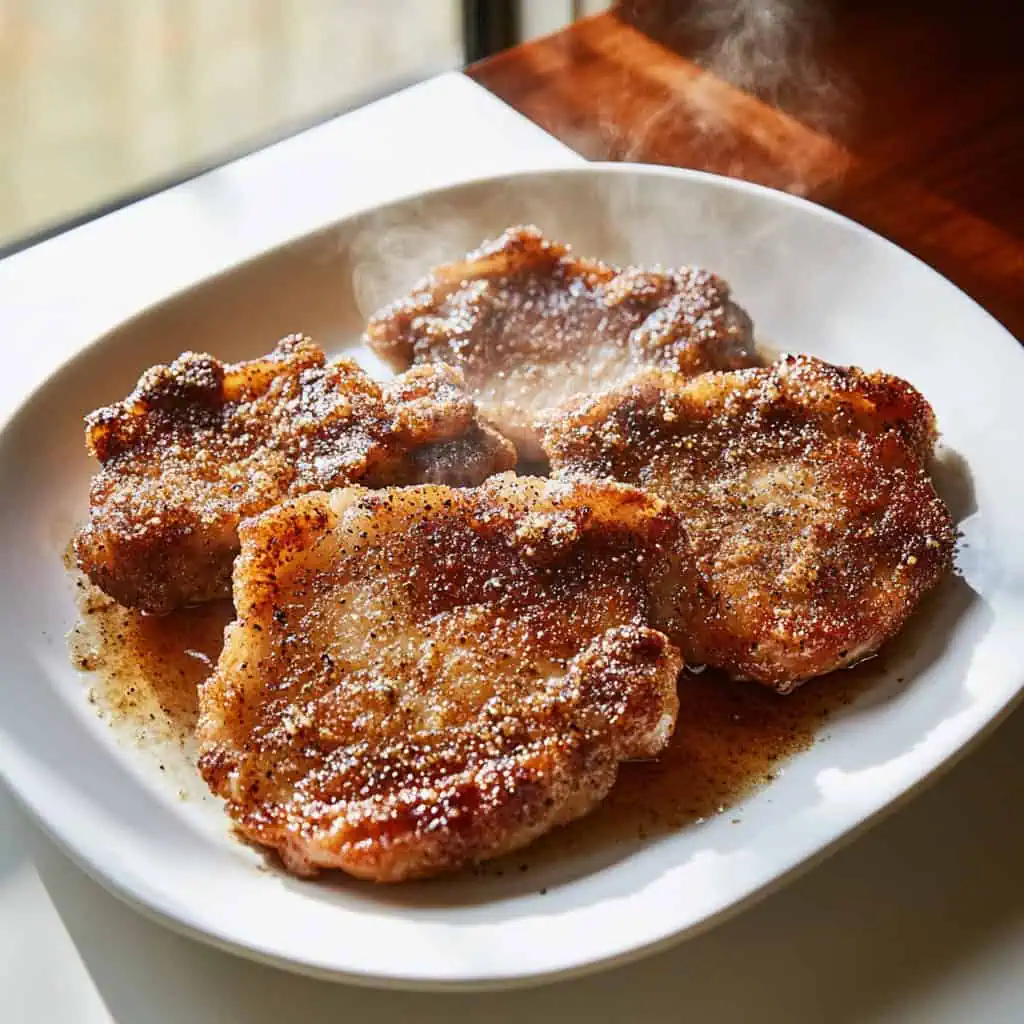






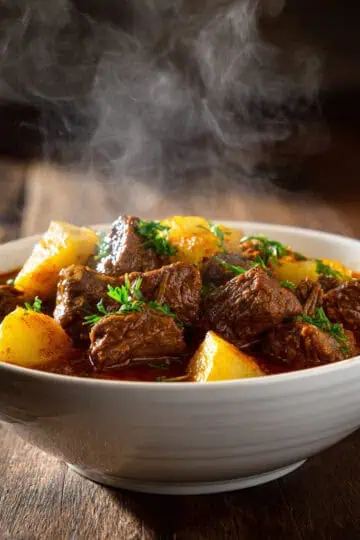
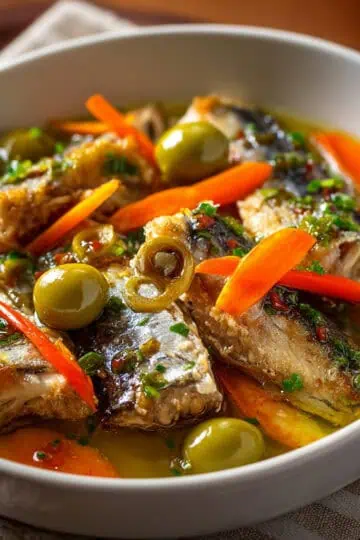
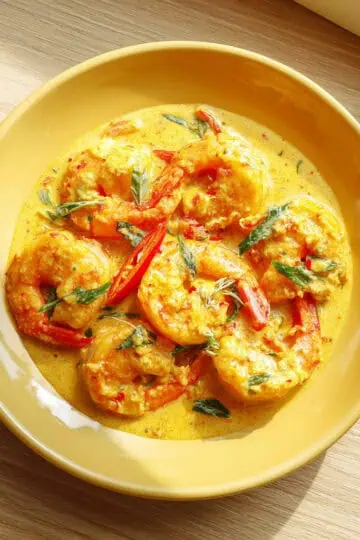
Comments
No Comments